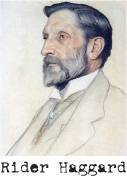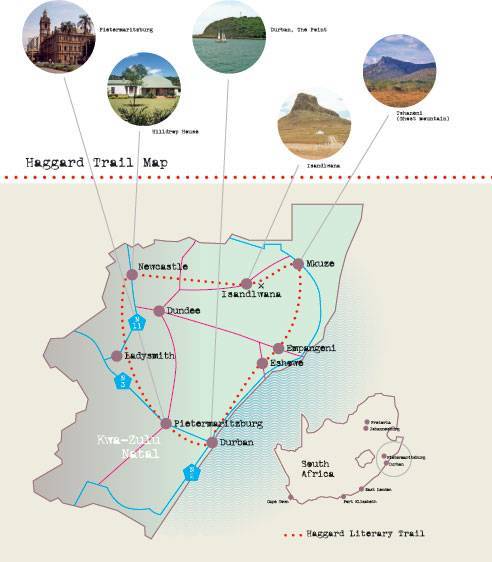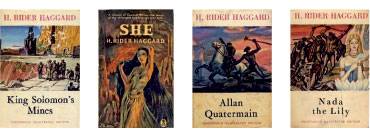Henry Rider Haggard was born on 22 June 1856 at Bradenham, Norfolk. His academic career was undistinguished and after failing the Army Entrance examination he was sent to London to study for the Foreign Office examination. There he became unofficially engaged to Mary Elizabeth Jackson, known as Lilly, but the romance was put on hold when in 1875 Haggard’s parents arranged for him to join the staff of Sir Henry Bulwer, Lieutenant-Governor of Natal.
In Pietermaritzburg, the Natal capital, Haggard met Theophilus Shepstone, Secretary for Native Affairs, who became his friend and mentor. In 1876 while accompanying Bulwer and Shepstone on a tour of Natal Haggard witnessed a Zulu ceremonial dance that provided the material for his first article written for publication. The Zulus named Haggard Lundanda u Ndandokalweni – "The tall one who travels on the heights".
 In December 1876 Haggard joined Shepstone’s mission to annex the Transvaal. During the trek to Pretoria Haggard "heard many a story of savage Africa" from his travelling companions and also from Mhlopekazi who, as Umslopogaas, features in Allan Quatermain (1887), Nada the Lily (1892) and She and Allan (1921). Another black man, Haggard’s Zulu servant, Mazooku, with whom he had several adventures, features in Haggard’s autobiography The Days of My Life (1926) and Diary of an African Journey (2000), and the novel The Witch’s Head (1884).
In December 1876 Haggard joined Shepstone’s mission to annex the Transvaal. During the trek to Pretoria Haggard "heard many a story of savage Africa" from his travelling companions and also from Mhlopekazi who, as Umslopogaas, features in Allan Quatermain (1887), Nada the Lily (1892) and She and Allan (1921). Another black man, Haggard’s Zulu servant, Mazooku, with whom he had several adventures, features in Haggard’s autobiography The Days of My Life (1926) and Diary of an African Journey (2000), and the novel The Witch’s Head (1884).
Haggard helped run up the British flag in Pretoria on May 24, 1877. Shortly afterwards he was appointed Master and Registrar of the High Court. In Pretoria Haggard met Arthur Cochrane and together they built a small cottage, "The Palatial". Here Haggard learned that Lilly Jackson had decided to marry someone else. The news "left me utterly reckless and unsettled." He had an affair with a married woman, Johanna Catherine Ford, who became pregnant with his child – a girl named Ethel Rider – who subsequently died.
Looking for a new start, Haggard and Cochrane resigned from the Pretoria Horse and bought a small farm, Rooipoint, just outside Newcastle, where they intended to farm ostriches. The farmhouse was named Hilldrop and still stands today used as a guesthouse filled with Haggard memorabilia.
In August Haggard went on a visit to England and in 1880 Haggard married Louisa Margitson. The couple returned to South Africa just as the First Anglo-Boer War broke out. The British were defeated in three battles fought close to Newcastle: Laing’s Nek, Ingogo and Amajuba. Hilldrop was rented by the authorities to negotiate the peace terms. "It was a strange fate which decreed that the Retrocession of the Transvaal, over which I had myself hoisted the British flag, should be practically accomplished beneath my roof."
Haggard’s first child, Arthur John Rider (‘Jock’) was born at Hilldrop on 22 May 1881. But the change in British fortunes convinced the Haggard family to leave South Africa.
Back in England, while studying for the Bar, Haggard wrote Cetywayo and His White Neighbours (1882), a work of non-fiction. This was followed by two novels: Dawn (1884) and The Witch’s Head (1884). Haggard’s third novel, King Solomon‘s Mines (1885), proved an instant bestseller. On the strength of this success, Haggard quit law and embarked on a literary career. A series of popular novels followed, including She (1886) and Allan Quatermain (1887)
The death of Jock in 1891, however, signalled the end of Haggard’s most creative period and, as he emerged from his grief, the beginning of Haggard’s life as a farmer and "man of affairs". He ventured briefly into business and also stood for parliament but failed to win a seat. Haggard’s agricultural studies, A Farmer’s Year (1899) and the two-volume Rural England (1902), brought him recognition as an authority on land issues. He travelled to the United States to investigate schemes for the resettlement of the urban poor and also served on the Royal Commission on Coast Erosion and Afforestation. He was knighted in 1912 for his public services.
Haggard revisited South Africa in 1914 while serving on the Dominions Royal Commission. During the trip Haggard returned to old haunts, toured Zululand, interviewed John Dube, first president of the African National Congress, and was reunited with Mazooku,
During World War One Haggard toured the dominions to investigate the post-war settlement of serviceman. He briefly visited Cape Town in 1916.
Haggard died on 14 May 1925.

Haggard and KwaZulu-Natal
"(Natal) impressed me enormously…The great plains rising by steps to the Quathlamba or Drakensberg Mountains, the sparkling torrential rivers, the sweeping thunderstorms, the grassfires creeping over the veld at night like snakes of living flame…- all these things impressed me, so much that were I to live a thousand years I should never forget them!" – The Days of My Life
Haggard’s autobiography The Days of My Life details his early years in Natal. His visit in 1914 is chronicled in Diary of an African Journey.
Durban
In 1875 Haggard landed at Durban before departing for Pietermaritzburg. He subsequently visited the city on official duties and for holidays. Haggard stayed in Durban in 1914 while serving on the Royal Dominions Commission. During this visit he interviewed John Dube, first president of the African National Congress.
Haggard’s fictional hero Allan Quatermain has a house on the Berea. In King Solomon‘s Mines, Allan Quatermain, Sir Henry Curtis and Captain Good arrive at Durban aboard the Dunkeld which drops anchor off the Point after sunset…
"At last, one beautiful evening in January, which is our hottest month, we steamed along the coast of Natal, expecting to make Durban Point by sunset. It is a lovely coast all along from East London with its red sandhills and wide sweeps of vivid green, dotted here and there with kraals, and bordered by a ribbon of white surf, which spouts up in pillars of foam where it hits the rocks. …When we came up again the moon was up, and shining so brightly over sea and shore that she almost paled the quick large flashes from the lighthouse. From the shore floated sweet spicy odours that always remind me of hymns and missionaries, and in the windows of the houses on the Berea sparkled a hundred lights. From a large brig lying near came the music of the sailors as they worked at getting the anchor up to be ready for the wind. Altogether it was a perfect night, such a night as you only get in Southern Africa, and it threw a garment of peace over everybody as the moon threw a garment of silver over everything."

Eshowe
Features in Finished (1917), the final volume of his Zulu trilogy.
Estcourt
Haggard travelled through the town on several occasions. In Fort Durnford Museum there is a photograph of Haggard. The caption incorrectly states he once lived in Albert Street. Near the town’s war memorial there are two hills called Queen Sheba’s Breasts, allegedly the inspiration for the similarly named mountains in King Solomon’s Mines.
Newcastle
Haggard lived here during 1881 on the farm Rooi Point. The farmhouse, Hilldrop, is a national monument. Re-named Mooifontein, it is described in Jess:
"It was a delightful spot. At the back of the stead was the steep boulder-strewn face of the flat-topped hill that curved round on each side, embosoming a great slope of green, in the lap of which the house was placed. It was very solidly built of brown stone, and … was covered with rich brown thatch. All along its front ran a wide verandah, up the trellis-work of which green vines and blooming creepers trailed pleasantly, and beyond was the broad-carriage-drive of red soil, bordered with bushy orange trees laden with odorous flowers and green and golden fruit."
Fort Amiel Museum has a Haggard display including an axe that belonged to M’hlopekazi, Haggard’s Umslopogaas.
Pietermaritzburg
Haggard lived at Government House (now the Pietermaritzburg campus of the University of South Africa) from 1875 to 1876 while on the staff of Lieutenant-Governor Sir Henry Bulwer. Details of his life in the city at this time are recorded in The Days of My Life.
The location footage for the 1937 film version of King Solomon’s Mines starring Paul Robeson, Cedric Hardwicke and John Loder, was shot at Otto’s Bluff just outside Pietermaritzburg. The stars did not come to South Africa and stand-ins were used.

Tshaneni (Ghost Mountain)
"We had journeyed seven days, for the way was long, and on the night of the seventh day we came to a mountainous country in which there were few kraals, for Chaka had eaten them all up years before. Perhaps you know the place, my father. In it is a great and strange mountain. It is haunted also, and named the Ghost Mountain, and on the top of it is a grey peak rudely shaped like the head of an aged woman. Here in this wild place we must sleep, for darkness drew on. Now we soon learned that there were many lions in the rocks around, for we heard their roaring and were much afraid, all except Umslopogaas, who feared nothing." – Nada the Lily
Ghost Mountain (Tshaneni) is the setting for Nada the Lily which chronicles the adventures of Umslopogaas and Galazi and their love for the heroine of the title. Haggard never actually visited the area.
Nada the Lily provided the inspiration for Rudyard Kipling’s The Jungle Book. Kipling told Haggard that "it was a chance sentence of yours in Nada the Lily that started me off on the track that ended in my writing a lot of wolf stories. You remember in your tale where the wolves leaped up at the feet of a dead man sitting on a rock? Somewhere on that page I got the notion."
Anglo-Zulu War Battlefields
The Anglo-Zulu War of 1879 features several times in Haggard’s works. His first book, Cetywayo and His White Neighbours (1882), a work of non-fiction, examines British relations with the Zulus and the Boers prior to the war. He wrote a factual account of the battles of Isandlwana and Rorke’s Drift for Andrew Lang’s The True Story Book (1893).
Isandlwana features in The Witch’s Head (1884), Black Heart and White Heart (1896) and Finished (1917), the final volume of Haggard’s trilogy dealing with the history of the Zulus in the nineteenth century. The first volume, Marie (1912), is set against the backdrop of the Great Trek and the second, Child of Storm (1913), concerns the war of succession fought between Cetshwayo and Mbuyazi and features the battle of Ndondakusuka.
Haggard visited Zululand for the first time in 1914 and his tour included visits to the battlefields of Gingindhlovu, Ulundi and Isandlwana, as well as the graves of Piet Retief and his followers at Umgundhlovu – now Emakhosini, the Valley of Kings.
At Isandlwana Haggard was awed by the "strange, abrupt, lion-like mount of Isandlwana" and he walked the battlefield as the sun was setting: "It was sad for me to stand by the piles of stones which cover all that is left of so many whom I once knew; Durnford and Pulleine and many other officers of the 24th, George Shepstone and the rest. Coghill I knew also very well but he died with Melville by the river bank …"
"When I had gone some way I turned and looked back at this lonesome, formidable hill standing there, a fit monument for the multitude of dead; immemorially ancient, stern and grand. The twilight was closing in, the sky was red, fading into grey… I walked awhile, picking my way over the stony ridge and dongas where the last stand was made against a roaring flood of foes, and again looked back. Now the stark mount had become very black and solemn, the trembling star had sunk or vanished and of the following crescent of the young moon but one horn appeared above the hill. It looked like a plume of faint, unearthly fire burning upon Isandlwana’s rocky brow. This must be a quiet place for man’s eternal sleep. But the scene which went before that sleep!"







